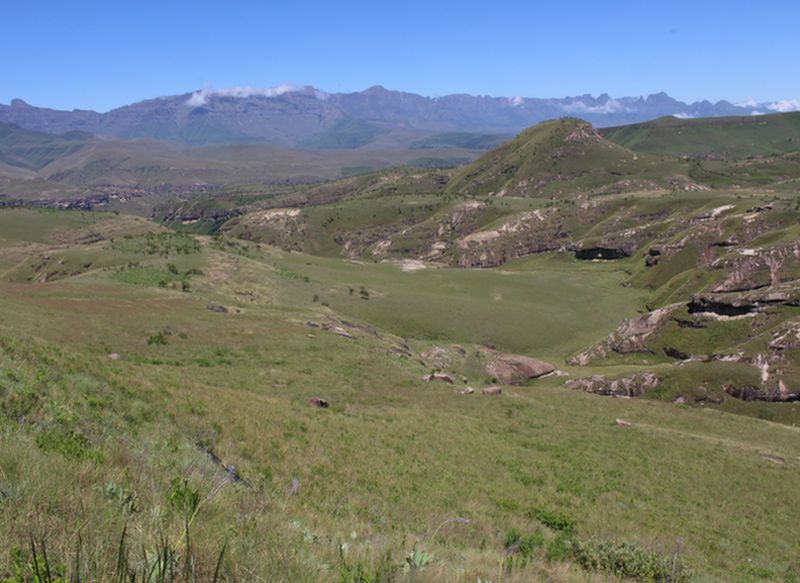eNews
#02 2023
Unlocking the vast potential of grasslands to mitigate climate change*
By Dr Paul Gordijn, Field Technician, Grasslands Node, NRF-SAEON
We often use the terms ‘global change’ and ‘climate change’ interchangeably. This is not entirely correct and can distract us from finding solutions for a resilient future.
Although climate change is serious, it is only one component of global change. Global change is a broader term referring to the influence of the increasing pressure of humans on the Earth’s natural resources. Interestingly, the most formidable influence of global change has not been climate change, but what scientists call ‘land transformation’, which is the conversion of one land cover or use to another.
Of all the Earth’s land biomes, grasslands are one of the most heavily impacted by land transformation, owing to their importance for agriculture. But grasslands are also one of the Earth’s most extensive biomes, covering 40.5% of the land surface, so what happens in grasslands is particularly significant for the Earth’s functioning and the well-being of humans.
Ecosystem services
Grasslands provide invaluable ‘services’ that allow life to flourish. They are especially important for water production, as grazing lands, and for nutrient cycling and carbon storage. They are critical for mitigating climate change. Over the decades, there has been extensive transformation in grasslands, and scientists are now taking urgent stock of remaining grasslands.
This is a challenge. An estimated 40% of South Africa’s grasslands have been transformed into other land covers like cultivated fields or tree plantations, but there are some questions about what we call grasslands. Pristine ‘primary’ grasslands become ‘secondary’ if, for example, they have been ploughed or planted with trees but have since ‘recovered’ a grassy cover. Modern satellite and drone imagery cannot detect whether grassland is primary or secondary.
So, what’s the deal? It’s a biggie – secondary grasslands are not known to recover their biodiversity and functioning! Current estimates indicate that the time grassland biodiversity takes to recover could be as much as a millennium, and that is if some ‘reservoir’ of biodiversity remains to propagate the recovery.
The bottom line is that for biodiversity and our own survival, we need to ensure that enough grasslands are maintained. This is especially the case in our mountain regions, which produce most of the country’s water and have exceptionally high levels of biodiversity.
The Drakensberg, for example, is home to some 2 500 plant species upon which other indigenous biodiversity depends. Maintaining such grasslands in their primary state makes the most economic sense.
The Drakensberg houses some 2 500 plant species upon which other indigenous biodiversity depends
Dr Paul Gordijn, field technician at SAEON’s Grasslands Node (right), is exploring possible changes in the grasslands of the Drakensberg
Deep dive into South Africa’s past
It is in these mountainous grasslands that a group of SAEON researchers took a deep dive into South Africa’s past. We used previously unanalysed imagery from just before 1950 to explore how people have interacted with the environment over time. This older imagery maximised the chances of detecting previously cultivated lands and plantations that had grown back some of their grassy cover over time.
The images showed clear differences between how different socio-ecological systems influenced changes over time. Over the past 70-odd years, 25% of primary grasslands were transformed, most used for cultivation or tree plantations. Most of this transformation occurred on private land where landowners had a more secure prospect of investment returns.
Transformation on communal land, which had a higher degree of uncertainty owing to socio-political upheavals, was less intense. But, while erosion was not so prevalent on private lands, communal systems showed high erosion and soil loss, signalling that some land management practices are not sustainable.
The most important thing we can do to bolster a resilient future is to collectively manage and maintain our remaining highly functional, life-sustaining primary grasslands.
Further reading
Blignaut, J., Mander, M., Schulze, R.E., Horan, M., Dickens, C., Pringle, C., Mavundla, K., Mahlangu, I., Wilson, A., McKenzie, M. et al. 2010. Restoring and managing natural capital towards fostering economic development: Evidence from the Drakensberg, South Africa. Ecological Economics 69 (6):1313–1323.
Carbutt, C. 2019. The Drakensberg Mountain Centre: A necessary revision of southern Africa’s high-elevation centre of plant endemism. South African Journal of Botany 124:508–529.
Nerlekar, A.N. & Veldman, J.W. 2020. High plant diversity and slow assembly of old-growth grasslands. Proceedings of the National Academy of Sciences 117 (31):18550–18556.
Skowno, A.L., Jewitt, D. & and Slingsby, J.A. 2021. Rates and patterns of habitat loss across South Africa’s vegetation biomes. South African Journal of Science 117 (1-2):1–5.
White, R., Murray, S. & Rohweder, M. 2001. Grassland ecosystems: pilot analysis of global ecosystems. World Resources Institute, Washington DC, US.
Wright, J.B. & Mazel, A.D. 2007. Tracks in a Mountain Range: Exploring the History of the uKhahlamba-Drakensberg. Witwatersrand University Press. Johannesburg, ZA.
* This article was first published in The Mercury of March 17.
Grasslands provide invaluable ‘services’ that allow life to flourish. They are especially important for water production, as grazing lands, and for nutrient cycling and carbon storage. Here the Tugela River flows through the Drakensberg range in KwaZulu-Natal. (Photo: Shutterstock)





